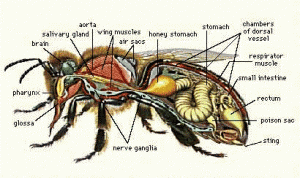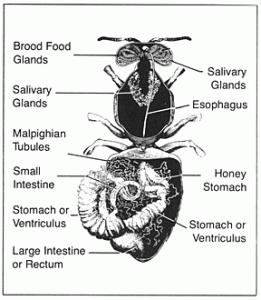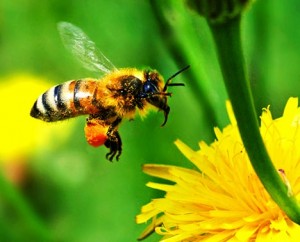 The honey bee digests its food and the nutrients extracted from that food is circulated by the
bee’s blood
and used for energy and to build, maintain and repair the body. The waste products as with all living things then need to be excreted from the bee’s body.The alimentary system or canal and its associated glands are where the process of digestion and excretion take place.
The honey bee digests its food and the nutrients extracted from that food is circulated by the
bee’s blood
and used for energy and to build, maintain and repair the body. The waste products as with all living things then need to be excreted from the bee’s body.The alimentary system or canal and its associated glands are where the process of digestion and excretion take place.
The bee’s alimentary canal starts with the bee’s mouth which is situated between the base of the mandibles. Inside the mouth the canal expands into a cavity which is attached by muscles to the front of the bee’s head. These muscles can expand and contract to provide some suction to move food from the proboscis which the bee uses to access (nectar) food, into the oesophagus. Muscles in the oesophagus move the nectar back into the bee’s crop which is better known as the honey stomach, where it is stored for transport back to the hive.
The honey stomach has a valve at the end of it called the proventriculus which prevents the nectar from passing further, unless the bee needs some of it for its own use. If the bee is a forager it will carry the nectar back to the hive in its honey
 stomach where it will regurgitate it back into its mouth and then pass it to other house bees for food or to store and turn into honey.
stomach where it will regurgitate it back into its mouth and then pass it to other house bees for food or to store and turn into honey.
The proventriculus also acts as a sieve for the nectar in the honey stomach, sieving out solids, such as pollen grains and plant spores and even bacteria. This is passed through into the ventriculus or stomach. If the bee needs sugar the proventriculus opens and nectar flows through to the stomach. Enzymes work on the contents of the stomach breaking it down so that the particles are small enough to pass through the gut wall into the blood. The bee digests two types of food, protein mainly from the pollen and sugars from the nectar.
The residue of the digestive process are passed into the rectum where it is held as faeces until the bee can leave the hive and void itself. Bees never pass waste inside their hive except if they are seriously ill. The presence of waste matter inside the hive is usually an indication that the colony is not healthy.
In winter when the bee cannot get out to relieve herself her rectum can often extend the length of her abdomen. As well as faeces uric acid is produced and stored in the rectum. At the end of the stomach there are a large number of thin-walled tubes called the Malpighian tubules, these act like our kidneys and remove nitrogenous waste, in the form of uric acid, which forms as a result of protein metabolism.
More Honey Bee Anatomy and Physiology

